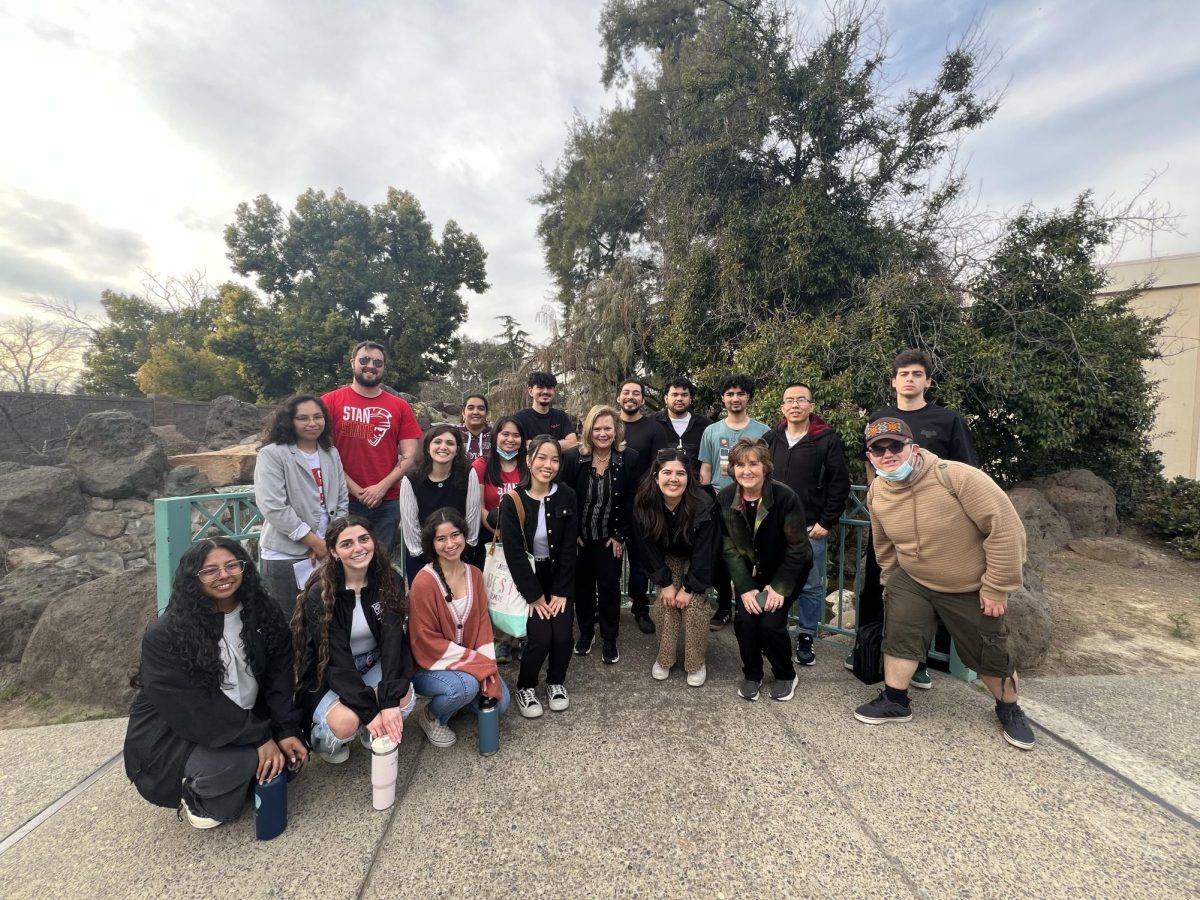While walking through campus at California State University, Stanislaus (Stan State), it’s not uncommon to see a cat or two prowling through the bushes or basking in the sunlight on the steps of Bizzini Hall. Xena, affectionately known by students as the “Bizzini Cat” or “Fetty Cat,” thanks to her one eye, often makes her presence known by cozying up to passers-by with a friendly purr.
At night, the cats crowd around numerous feeding stations located on campus, eagerly awaiting their meal that is brought by a lone volunteer. They look tame enough, meowing and purring amongst one another and occasionally getting into a spat over the last piece of kitty kibble. But, get too close and they’ll dart off into the foliage much like any other wild animal would do.
According to Director of Safety and Risk Management Amy Thomas, around 20 feral cats currently call Stan State home, all of which have been trapped, neutered and given medical exams. The cats who undergo the “trap, neuter, return” system are then returned to the campus with clipped ears, symbolizing their sterilization.
The “trap, neuter, return” system saves the lives of wild cats who otherwise would be euthanized at the shelter. Sterilizing the cats allows them to live happily in the wild without the fear of overpopulating, while also providing Stan State with free rodent control.
While the university supports the management of the feral cats on campus, it does not claim ownership or provide direct care for the felines. Those responsibilities fall solely on volunteers who care enough for the cats’ well-being to lend a helping hand.
Thomas, along with Campus Landscape and Custodial Manager Hugo Hernandez, currently hold monthly meetings with staff who have volunteered their time to taking care of the campus’ feral cat population.
“There is not a department or formalized organization ‘in charge’ of cats, but we want to at least provide some guidance to volunteers on the position of the campus with regards to human safety, campus safety and protection of the ‘wildlife’ of the cats,” Thomas said.
Though there are several volunteers who help feed, nurture and provide healthcare to the cats, there is currently no official Campus Cats Coalition – a group that was formed at Stan State in 2004 before ultimately disbanding in 2006. The Campus Cats Coalition was responsible for the same tasks that Thomas and other volunteers now carry out, and was funded through the university as well as fundraising by the organization.
Campuses such as Stanford University (Stanford Cat Network), Texas A&M (Aggie Feral Cat Alliance of Texas) and the University of California at Davis (The Feline Medicine Club: Orphan Kitten Project) all run successful Cats on Campus Programs.
With a recorded budget of $2,970 for three months care for the cats, it’s evident that providing a safe, healthy home for Stan State’s furry friends was no cheap task – and that was in 2005.
Thomas hopes that cat-loving students on campus can take the reigns, perhaps reviving the long-lost Campus Cats Coalition through involvement and donations.
“The main help that is needed is for funds to feed and care for the cats,” Thomas said. “We’d actually like to see a student organization take an interest as a fundraising opportunity, or as a student organization who would become advocates for the cats on campus.”
Thomas may not have to look far for students willing to help.
“I love the campus cats,” Christina Robles (junior, Psychology) said. “Being a cat lover, I personally feel that they make the campus so much more inviting. They are very sweet animals who, a lot of the time, will let me pet them and scratch their ears.”
Thomas encourages students with a passion for cats to contact her for more information, but also stresses that students don’t take matters into their own hands. It may seem like giving a cat one small bite of your dining hall dinner is helping the cause, but it can actually be detrimental to the animal’s health.
“One concern the volunteers have is that the cats will be harmed,” Thomas said. “They worry about people giving the cats wrong foods, like human foods (pizza, etc.), and the effect it has on cat health. Since there aren’t funds to help with veterinary bills, it is a concern that the cats stay healthy.”
It is also important that those who may have a love for cats yet can no longer provide a home for their own do not dump their animal onto campus.
Although cat-friendly Stan State may seem like a safe place to drop off unwanted pets, that is not the case.
“Cats are not actually considered a domesticated animal and on campus we have feral cats that are solitary and territorial,” Thomas said. “When a cat is dropped off here, it is a danger to the new cat. They will not be accepted and the other cats may fight with it and try to make it leave. It is not a healthy situation for cats to be left on campus, as they may starve, get sick or be injured in fights for territory.”
Tame cats that can no longer be cared for can be taken to the Turlock Animal Shelter, located at 801 S. Walnut Road, where they will be put up for adoption.
Many local, no-kill shelters, such as the Friends of Turlock Animal Shelter, pull cats from the Turlock Animal Shelter to give them a better chance at finding a home. According to their website, the Friends of Turlock Animal Shelter has found homes for over 10,000 animals since 1996. To contact the Friends of Turlock Animal Shelter directly, call 209-634-6714.
Students who are interested in volunteering or jump-starting an organization to help care for the cats can contact Amy Thomas at 209-667-3035 or send an email to [email protected].
With love and care from students and volunteers like Thomas, it’s possible for the cats to call Stan State their “fur-ever” home.
Contributing reporters: Brittany Valadez and Haylee Crews
Categories:
Cats on campus: How Stan State cares for its feline friends
Angelina Martin
•
March 15, 2016
Photo by Marybel Cortez (sophomore, Psychology)
This photo was chosen as a winner of the Signal’s “Cats on Campus” Instagram photo contest.
0
Donate to Signal
Your donation will support the student journalists of California State University, Stanislaus. Your contribution will allow us to purchase equipment and cover our annual website hosting costs.
More to Discover











